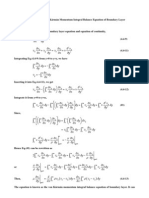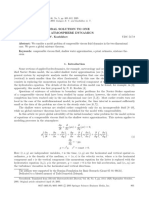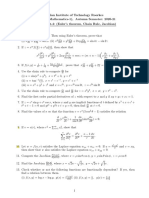Maxwell's Thermodynamic Relation: ST ND
Maxwell's Thermodynamic Relation: ST ND
Uploaded by
mr shantosCopyright:
Available Formats
Maxwell's Thermodynamic Relation: ST ND
Maxwell's Thermodynamic Relation: ST ND
Uploaded by
mr shantosOriginal Title
Copyright
Available Formats
Share this document
Did you find this document useful?
Is this content inappropriate?
Copyright:
Available Formats
Maxwell's Thermodynamic Relation: ST ND
Maxwell's Thermodynamic Relation: ST ND
Uploaded by
mr shantosCopyright:
Available Formats
Maxwell’s Thermodynamic Relation
Maxwell derived the relation by combining 1st & 2nd law of thermodynamics for a PVT
system undergoing an infinitesimal reversible process.
We have from 1st law of thermodynamics,
dQ =dU +dW
dQ =dU + pdV
dU =dQ −pdV ---------- (i)
From second law of thermodynamics,
dQ
dS=
T
dQ =TdS
dU =TdS−pdV ---------- (ii)
Considering U, S & V are function of two independent variables x∧ y .
dU =( ∂∂Ux ) dx +( ∂∂Uy ) dy
y x
dS=( ) dx+ (
∂ y)
∂S ∂S
dy
∂x y x
dV =(
∂x )
dx +(
∂y)
∂V ∂V
dy
y x
Substituting their value in eq. (ii) we have-
( ∂∂Ux ) dx +( ∂∂Uy ) dy =T {( ∂∂ Sx ) dx+( ∂∂ Sy ) dy }− p {( ∂V∂x ) dx+( ∂V∂y ) dy }
y x y x y x
{ ( ) ( )} { ( ) ( )}
¿ T
∂S
∂x y
−P
∂V
∂x y
dx + T
∂S
∂y y
−P
∂V
∂y x
dy ---(iii)
Comparing the coefficient of dx∧dy from equation (iii) we have-
1 Composed by: KN, ARB
( ) ( ) ( )
∂U
∂x y
=T
∂S
∂x y
−P
∂V
∂x y
----------- (iv)
( ∂∂Uy ) =T ( ∂∂ Sy ) −P ( ∂V∂y )
x y x
----------- (v)
Differentiating equation (iv) & (v) with respect to y∧x we have-
∂2 U
=
∂T
( )( )
∙
∂S
∂ y∙∂ x ∂ y x ∂ x y
+T ∙
∂2 S
−
∂p
∙
∂U
∂ y∙∂ x ∂ y x ∂ x x
−p ( )( ) (
∂2 V
∂ y ∙∂x )
− p(
∂x ∙∂ y ( ∂x ) (∂ y ) ∂ x∙∂ y ( ∂x ) ( ∂ y ) ∂ y ∙∂x )
2 2 2
∂U ∂T ∂S ∂ S ∂p ∂U ∂V
= ∙ +T − ∙
y x y x
2 2
∂U ∂ U
Since dU is a perfect differential, above two expressions are equal = and
∂ y∙∂ x ∂ x∙∂ y
single dS & dV are perfect differential.
After simplifying we can write,
( ∂∂ Ty ) ∙( ∂∂ Sx ) −( ∂∂ py ) ∙( ∂∂Ux ) =( ∂∂Tx ) ∙( ∂∂ Sy ) −( ∂∂ px ) ∙( ∂∂ Uy )
x y x x y x y x
------ (vi)
Equation (vi) is the general equation for Maxwell’s thermodynamic Relation.
1st Relation:
Putting x=T , y =V and taking T ∧V as independent variables.
∂T ∂V ∂T ∂V
=1 , =1 , =0 , =0
∂x ∂y ∂y ∂x
∂S
( ) ( )
∂P
(vi) ∂ V = ∂ T
T V
[ But , dS=
dQ
T ]
∴(
∂V ) (∂T )
∂Q ∂P
=
T V
For a thermodynamic system, the increase of entropy per unit increase of volume at
constant temperature is equal to the increase of temperature in a isochoric process.
2nd Relation:
Taking T & P are independent variables. i.e. x=T & y=P
We get from (vi)
2 Composed by: KN, ARB
∂T ∂ P 1∧∂ T ∂P
=1 , = =0 , =0
∂x ∂y ∂y ∂x
( ∂∂ Sp ) =−( ∂∂ VT )
T p
( ∂∂ Qp ) =−( ∂∂ VT )
T p
The decrease of entropy per unit increase of pressure in a isothermal process is equal to
the increase of volume per unit increase of temperature for a isobaric process.
3rd Relation:
Taking entropy & volume as independent variables. i.e. x=S & y=V
We get,
∂S ∂ V 1∧∂ S ∂V
=1, = =0 , =0
∂x ∂y ∂y ∂x
From equation (vi) we can write,
( ∂∂ Tx ) =−( ∂∂Ps )
s v
( ∂ x ) =−T ( ∂ Q )
∂T ∂P
s v
The increase of temperature per unit increase of volume in a reversible adiabatic
process is equal to the decrease of pressure per unit increase of entropy in a isochoric
process.
4th Relation:
Taking entropy & Pressure as independent variable. i.e. x=S & y=P
We have,
∂S ∂ P 1∧∂ S ∂P
=1, = =0 , =0
∂x ∂y ∂y ∂x
(vi) ( ) ( )
∂T ∂v
∂ p = ∂S
s p
( ∂ p ) =T ( ∂ Q )
∂T ∂v
s p
3 Composed by: KN, ARB
The increase of temperature per unit increase pressure in a reversible adiabatic process
is equal to the increase of volume per unit increase of entropy in a isobaric process.
5th Relation:
Taking p & v as independent variable. i.e. x=p & y=v
We get,
∂p ∂ v 1∧∂ p ∂v
=1, = =0 , =0
∂x ∂y ∂y ∂x
(vi) ( )( ) ( )( )
∂T ∂S ∂T ∂S
∂ p ∙ ∂ v − ∂ v ∙ ∂ p =1
v v p v
6th Relation:
Taking T & S as independent variable. i.e. x=T & y=S
We get,
∂T ∂ S 1∧∂ T ∂S
=1 , = =0 , =0
∂x ∂y ∂y ∂x
(vi) ( )( ) ( )( )
∂p ∂v ∂p ∂v
∂ T ∙ ∂ S − ∂ S ∙ ∂T =1
S T T S
Clausius – Clapeyron equation (1st latent heat equation)
From Maxwell’s 1st relation we can write
( ∂∂ Sv ) =( ∂∂Pt )
T v
T ( ∂ v ) =T ( ∂ T )
∂S ∂P
[ ∵ dQ=TdS ]
T v
( ∂ v ) =T ( ∂T )
∂Q ∂P
------------ (i)
T v
Here, ( ∂ v ) represents the quantity of heat absorbed per unit increase in volume at
∂Q
T
constant temperature. This quantity of heat absorbed at constant temperature is the
latent heat (L),
Thus dQ=L∧dV =V 2−V 1
4 Composed by: KN, ARB
∴
( L
V 2−V 1 T ) ( )
=T
dp
dT V
dp
( ) L
dT = T V −V which is the 1st latent heat equation.
( 2 1)
Specific heat of constant volume Cv:
The amount of heat required to raise the temperature of unit mass of a gas through 1C
when its volume keep constant, it is represented by C v = ∆ T ( ∆Q) v
Specific heat of constant Pressure Cp: The amount of heat required to raise the
temperature of unit mass of a gas through 1C when its pressure keep constant, it is
represented by C p= ∆ T ( ∆Q ) p
Show that C p−C v =R
If V ∧T are chosen as the independent variables U =f (V , T ) ------------- (i)
Differentiating (i)
dU = ( ∂∂TU ) dT +( ∂U
V ∂V )
dV
T
-------------(ii)
According to the 1st law of thermodynamics-
dQ =dU +dW
¿ dU + pdV
¿ ( ∂∂TU ) dT +( ∂U
V ∂V )
dV + pdV ----------------(iii)
T
Dividing both side by dT
dQ ∂ U
dT
=
∂T ( ) + {p+( ∂U
V ∂ V ) } dT
dV
------------------ (iv)
T
If the gas is heated at constant volume-
( ) ( ∂∂TQ ) =( ∂∂UT ) =C
∂Q C ∧dV
= V =0 V --------------------- (v)
∂T V dT V V
When the gas is heated at constant pressure,
5 Composed by: KN, ARB
dQ
=C p
dT
∴ C p= ( ∂∂ UT ) +{ p+( ∂∂UV ) }( ∂∂VT )
V T p
∴ C p=CV + p+ { ( ) }( )
∂U
∂V T
∂V
∂T p
∂U
( )
But ∂V =0
T
For ideal gas equation we can write
P V =RT
( )
∂V
P ∂ T =R
p
∴ C p−CV =P∙ ( ∂∂ VT ) +( ∂∂ UV ) ∙( ∂∂TV )
p T ¿
C p−C V =R (Shown)
Maxwell's law of Equipartition energy:
According to kinetic theory of gas we can write,
1 2 3
m c = kT
2 2
But, c 2=u 2+ v 2+ w2 as x , y , z are all equivalent. Mean square velocities along three axes
are equal.
2 2 2
u =v =w
Hence,
1
u2=v 2=w2= c 2
3
1 1 1
∴ mu2= m v 2= m w2
2 2 2
6 Composed by: KN, ARB
1 1
2 ( 1
2 )(1
2 )( 3
∴ mc 2=3 mu2 = mv 2 = mw 2 = kT
2 2 )
( )
1 2 3
3 2 m u = 2 kT
1 2 1
or, 2 mu = 2 kT
3 ( 2 m v )= 2 kT
1 2 3 1 2 1
or, 2 m v = 2 kT
3 ( 2 m w )= 2 kT
1 2 3 1 2 1
or, 2 m w = 2 kT
1
Thus, the average K.E. associated with each degree of freedom ¿ 2 kT
7 Composed by: KN, ARB
You might also like
- Solutions of Pde Walter StraussDocument37 pagesSolutions of Pde Walter Straussmaria100% (2)
- The Derivation of Von Kármán Momentum Balance Equation of Boundary LayerDocument3 pagesThe Derivation of Von Kármán Momentum Balance Equation of Boundary LayerShih-han Liu100% (3)
- Quiz No 3Document3 pagesQuiz No 3von_science08No ratings yet
- ME2121 Study NotesDocument14 pagesME2121 Study Notesbenjaminyc96No ratings yet
- Solution 3 PDFDocument17 pagesSolution 3 PDFToby ChengNo ratings yet
- Timoshenko BeamDocument5 pagesTimoshenko BeamNishal CalebNo ratings yet
- VonKarman PohlhausenMethod1Document20 pagesVonKarman PohlhausenMethod1mohamed elsheikhNo ratings yet
- Unas tablas remolachasDocument5 pagesUnas tablas remolachasFrancisco José Rojas ContrerasNo ratings yet
- Ideal Fluid FlowDocument7 pagesIdeal Fluid FlowPatrick Joseph RoblesNo ratings yet
- Gatapov 2005Document8 pagesGatapov 2005KorcaNo ratings yet
- Complex Analysis Fall 2007 Homework 5: SolutionsDocument9 pagesComplex Analysis Fall 2007 Homework 5: SolutionsKay Chan SothearaNo ratings yet
- Mce 528 2015 I HW 2 SolutionsDocument4 pagesMce 528 2015 I HW 2 SolutionsYesufNo ratings yet
- Strauss PDEch 1 S 1 P 03Document7 pagesStrauss PDEch 1 S 1 P 03Walter Torres MontesNo ratings yet
- Answers1 (1) Fluid MechanicsDocument5 pagesAnswers1 (1) Fluid Mechanicsjoe valNo ratings yet
- HOMEWORK 1 - Solutions: Vienna University of TechnologyDocument4 pagesHOMEWORK 1 - Solutions: Vienna University of TechnologyKarim SalehNo ratings yet
- MC Partial Differential EquationDocument8 pagesMC Partial Differential EquationRaZa UmarNo ratings yet
- Unit3 Tutorial MA5158-Mathematics IDocument2 pagesUnit3 Tutorial MA5158-Mathematics IMithun arjunNo ratings yet
- Introduction To Engineering AnalysisDocument8 pagesIntroduction To Engineering AnalysisSuprioNo ratings yet
- Second Invariant Q For A 2D Flow: U X U y V X V yDocument1 pageSecond Invariant Q For A 2D Flow: U X U y V X V yebrahem khalidNo ratings yet
- Ridge ComparisonDocument5 pagesRidge ComparisonSarathchandra SarathchandraNo ratings yet
- MA2104 2020/2021 Final SolutionsDocument6 pagesMA2104 2020/2021 Final SolutionsE1297756No ratings yet
- Motion and DeformationDocument3 pagesMotion and DeformationPatrick Joseph RoblesNo ratings yet
- State and prove Euler's theorem for three variables and hence find the followingDocument3 pagesState and prove Euler's theorem for three variables and hence find the followingdeyrajdeep2005No ratings yet
- Taylor GreenDocument2 pagesTaylor Greenafsarul778No ratings yet
- 2D Orr-Sommerfeld Equation Derivation: June 2018Document7 pages2D Orr-Sommerfeld Equation Derivation: June 2018Magesh BNo ratings yet
- MATH 300 UNKNOWN 2006 OtherDocument7 pagesMATH 300 UNKNOWN 2006 OtherGavin WattNo ratings yet
- Assignment 1Document1 pageAssignment 1sara h.muhammedNo ratings yet
- Assignment 1Document1 pageAssignment 1sara h.muhammedNo ratings yet
- Unit 3: Analytic FunctionsDocument20 pagesUnit 3: Analytic FunctionsKAVIN PARITHI.SNo ratings yet
- Equation Sheet: Cartesian: Operators: Conservation of Energy (Incompressible, Newtonian FluidDocument2 pagesEquation Sheet: Cartesian: Operators: Conservation of Energy (Incompressible, Newtonian FluidGlass-Half-EmptyNo ratings yet
- Lec 3Document23 pagesLec 3Saurav SonawaneNo ratings yet
- 16100lecture6 CGDocument2 pages16100lecture6 CGnaveenNo ratings yet
- MECN3036 FormulaSheetDocument2 pagesMECN3036 FormulaSheetMuaaz MoosaNo ratings yet
- CFD AnalysisDocument16 pagesCFD AnalysisEdgar DominguezNo ratings yet
- Assignment 4 (MAN 001)Document2 pagesAssignment 4 (MAN 001)Shrey AgarwalNo ratings yet
- Homework #3 - SolutionsDocument3 pagesHomework #3 - SolutionsSayan SamantaNo ratings yet
- Strauss PDEch 1 S 1 P 02Document5 pagesStrauss PDEch 1 S 1 P 02Walter Torres MontesNo ratings yet
- Assignment - 2Document20 pagesAssignment - 2comedy worldNo ratings yet
- Rans DerivationDocument16 pagesRans Derivationuday gouthamaNo ratings yet
- Derivation of The Lorenz EquationsDocument3 pagesDerivation of The Lorenz EquationsSteven ScottNo ratings yet
- From Schrödinger EquationDocument2 pagesFrom Schrödinger EquationIndah pratiwiNo ratings yet
- Electromagnetism Basics - Formulas, Solutions, ApplicationsDocument4 pagesElectromagnetism Basics - Formulas, Solutions, Applicationscarlos120munroNo ratings yet
- Governing Equations For Turbulent FlowDocument15 pagesGoverning Equations For Turbulent FlowRenz Marion CorpuzNo ratings yet
- Lecture2 PDFDocument38 pagesLecture2 PDFAnnas MahfudzNo ratings yet
- Strauss PDEch 1 S 1 P 01Document8 pagesStrauss PDEch 1 S 1 P 01Walter Torres MontesNo ratings yet
- FEM MATLAB Code For Geometric Nonlinear Analysis of Membranes PDFDocument12 pagesFEM MATLAB Code For Geometric Nonlinear Analysis of Membranes PDFJosé Antonio Alarcón LeónNo ratings yet
- MIT8 03SCF16 Lec10Document9 pagesMIT8 03SCF16 Lec10Dhiman KalitaNo ratings yet
- Geometry A1 Chapter 2Document23 pagesGeometry A1 Chapter 2Ngo Anh ThuNo ratings yet
- 2y 2y 2 2 2y 2y: Date: October 23, 2011Document7 pages2y 2y 2 2 2y 2y: Date: October 23, 2011AbdirahmanNo ratings yet
- Lecture 2Document10 pagesLecture 2Rohan GopeNo ratings yet
- Lecture 10 - Transmission Lines: X X y yDocument8 pagesLecture 10 - Transmission Lines: X X y ysamer saeedNo ratings yet
- Conservation Laws of Fluid Motion DB D C Diti and Boundary ConditionsDocument20 pagesConservation Laws of Fluid Motion DB D C Diti and Boundary ConditionsVIGNESH BNo ratings yet
- Vibrating String 2 PDFDocument21 pagesVibrating String 2 PDFRofiul HamimNo ratings yet
- Final ProjectDocument4 pagesFinal ProjectChacho BacoaNo ratings yet
- Equations of Two-Dimensional Flow and Bed Deformation in General Coordinate SystemDocument9 pagesEquations of Two-Dimensional Flow and Bed Deformation in General Coordinate Systemsarkawt muhammadNo ratings yet
- Assignment 9Document3 pagesAssignment 9HNo ratings yet
- Eddy Viscosity: Atmospheric and Oceanic Boundary LayerDocument18 pagesEddy Viscosity: Atmospheric and Oceanic Boundary LayerSilvio NunesNo ratings yet
- Eddy Viscosity: Atmospheric and Oceanic Boundary LayerDocument18 pagesEddy Viscosity: Atmospheric and Oceanic Boundary LayerSilvio NunesNo ratings yet
- Lecture18 PDFDocument5 pagesLecture18 PDFTihomir MarkovicNo ratings yet
- Assignment - 1, 2, 3 (Save)Document60 pagesAssignment - 1, 2, 3 (Save)comedy worldNo ratings yet
- Green's Function Estimates for Lattice Schrödinger Operators and ApplicationsFrom EverandGreen's Function Estimates for Lattice Schrödinger Operators and ApplicationsNo ratings yet
- MechanicalDocument4 pagesMechanicalCEO GroupNo ratings yet
- Chapter 9 Heat - 9.1 Temperature and Thermal EquilibriumDocument3 pagesChapter 9 Heat - 9.1 Temperature and Thermal EquilibriumTammy Anh TranNo ratings yet
- Moisture Loss During FreezingDocument1 pageMoisture Loss During FreezingIvana TomazNo ratings yet
- AC Tutor1Document4 pagesAC Tutor1Jady chess24No ratings yet
- Isentropic Proc Aire Thy ExDocument7 pagesIsentropic Proc Aire Thy ExMayket CruzNo ratings yet
- Tara Pharmacology PDF Medicalstudyzone - Com - CompressedDocument572 pagesTara Pharmacology PDF Medicalstudyzone - Com - Compressedunbridled.instinct.218No ratings yet
- Calculation of Heat and Mass BalanceDocument16 pagesCalculation of Heat and Mass BalanceHEMANTNo ratings yet
- Thermo Questions 1Document4 pagesThermo Questions 1Himanshu VasisthaNo ratings yet
- Weather PPT For 2 1Document26 pagesWeather PPT For 2 1Samantha MoralesNo ratings yet
- Flower Duet in G Voices OnlyDocument80 pagesFlower Duet in G Voices Onlym1d0r1No ratings yet
- Mathematics Grade5 Worksheet-4-Q4Document3 pagesMathematics Grade5 Worksheet-4-Q4Ivy Montaña PlanosNo ratings yet
- Topic 2 - Vapor Compression and Air, Refrigeration CyclesDocument77 pagesTopic 2 - Vapor Compression and Air, Refrigeration CyclesOk SokNo ratings yet
- R134a Refrigerant Pressure Temperature Chart Under The Condition of SaturationDocument1 pageR134a Refrigerant Pressure Temperature Chart Under The Condition of SaturationAkhidNo ratings yet
- Types of Thermodynamic ProcessDocument8 pagesTypes of Thermodynamic ProcessSaranrajPachayappanNo ratings yet
- Sec 3 Pure Physics Test On Thermal Energy Transfer and Thermal Properties of MatterDocument12 pagesSec 3 Pure Physics Test On Thermal Energy Transfer and Thermal Properties of Matteralibabagoat1No ratings yet
- 2017화공재료노트8 1 (Ch9)Document8 pages2017화공재료노트8 1 (Ch9)loganathas848No ratings yet
- R134a Tables SIDocument5 pagesR134a Tables SIVivek MuktiehNo ratings yet
- 10 Practical ThermometersDocument39 pages10 Practical ThermometersEdna OsmanNo ratings yet
- Engineering Thermodynamics Nov Dec 2007 Question PaperDocument3 pagesEngineering Thermodynamics Nov Dec 2007 Question PaperAnirudhan RaviNo ratings yet
- Nota Padat Fizik F4 Heat NotesDocument17 pagesNota Padat Fizik F4 Heat Notesslokkro99% (109)
- Q1 - W5 - D4 ALL SUB Copy Old LP July 5Document2 pagesQ1 - W5 - D4 ALL SUB Copy Old LP July 5Emielda PalenNo ratings yet
- FugacityDocument10 pagesFugacitySai krishna100% (1)
- 汽车节温器目录Document8 pages汽车节温器目录DIESEL AMERICANo ratings yet
- Air Handling Unit Data Collection FormDocument4 pagesAir Handling Unit Data Collection FormcajaroNo ratings yet
- Notes ThermodynamicsDocument10 pagesNotes Thermodynamicsrudra vasireddyNo ratings yet
- Topic: Ident No: Supersedes: Date: SUBJECT: Service Only Part Numbers For Thermostatic Valve Replacement Kits Models Affected: AllDocument1 pageTopic: Ident No: Supersedes: Date: SUBJECT: Service Only Part Numbers For Thermostatic Valve Replacement Kits Models Affected: AllferyNo ratings yet























































































